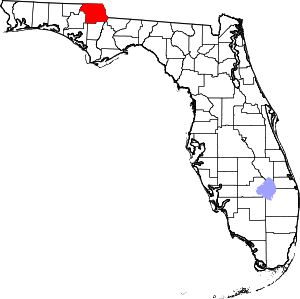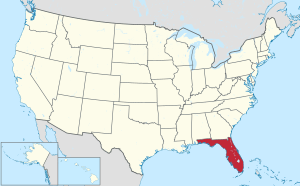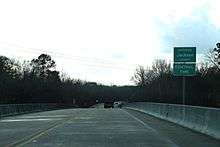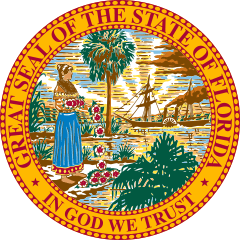Jackson County, Florida
Jackson County is a county located in the U.S. state of Florida, on its northwestern border with Alabama. As of the 2010 census, the population was 49,746.[2] Its county seat is Marianna.[3]
Jackson County | |
|---|---|
County | |
| Jackson County | |
%2C_Marianna.jpg) | |
 Seal | |
 Location within the U.S. state of Florida | |
 Florida's location within the U.S. | |
| Coordinates: 30°48′N 85°13′W | |
| Country | |
| State | |
| Founded | August 12, 1822 |
| Named for | Andrew Jackson |
| Seat | Marianna |
| Largest city | Marianna |
| Area | |
| • Total | 955 sq mi (2,470 km2) |
| • Land | 918 sq mi (2,380 km2) |
| • Water | 37 sq mi (100 km2) 3.9%% |
| Population | |
| • Estimate (2019) | 46,414[1] |
| • Density | 52.6/sq mi (20.3/km2) |
| Time zone | UTC−6 (Central) |
| • Summer (DST) | UTC−5 (CDT) |
| Congressional district | 2nd |
| Website | www |
History
Jackson County was created by the Florida Territorial Council in 1822 out of Escambia County, at the same time that Duval County was organized from land of St. Johns County, making them the third and fourth counties in the Territory. The county was named for Andrew Jackson, a General of the War of 1812, who had served as Florida's first military governor for six months in 1821.[4] Jackson County originally extended from the Choctawhatchee River on the west to the Suwannee River on the east. By 1840 the county had been reduced close to its present boundaries through the creation of new counties from its original territory, following an increase of population in these areas. Minor adjustments to the county boundaries continued through most of the 19th century, however.[5][6][7]
There were no towns in Jackson County when it was formed. The first county court met at what was called "Robinson's Big Spring" (later called Blue Springs) in 1822 and then at the "Big Spring of the Choctawhatchee" in 1823. The following year the county court met at "Chipola Settlement", which is also known as Waddell's Mill Pond.
European Americans developed this area of Florida as part of the plantation belt in the antebellum years. Cotton was cultivated as a commodity crop by large work gangs of enslaved African Americans, and Florida became a slave society.
Gradually towns were developed. In January 1821, Webbville had been established as the first town in Jackson County. It was the first designated as the county seat. Marianna was founded in September 1821 by Robert Beveridge, a native of Scotland. It developed about 9 miles (14 km) southeast of Webbville. About 1828, Beveridge and other Marianna settlers went to Tallahassee to lobby the state legislature to move the county seat to Marianna.
They enticed the Florida Legislature with offers of free land, locally paying for construction of a county courthouse and development of a related public square, and donating an additional $500 to purchase a quarter section of land to be sold at public auction as a way to finance the new government, if the county seat was moved to Marianna.[8] Beveridge and his supporters succeeded in their civic bribe. Marianna became the de facto county seat of the county justice and civil authority, although it was never officially proclaimed as such. Marianna began to grow and prosper when the county government moved into the new courthouse in 1829. It became the market and court town for the rural county.
Webbville's prominent citizens moved to Marianna to follow the courts, as did numerous businesses. When the L&N Railroad decided to bypass putting a station at Webbville, the town declined further and became defunct.
Jackson County war
After the Civil War, the county was convulsed by violence as Confederate veterans and their allies attacked and intimidated freedmen and their sympathizers. The county faced the worst economic conditions in the state, as it had been most extensively developed for cotton plantations before the war, and was adversely affected by the international decline in the market.[9]:461–462 White planters resisted dealing with freedmen as free workers. Insurgent Confederate veterans formed a Ku Klux Klan chapter and carried out masked violence to exert power, intimidate freedmen and white sympathizers, suppress their voting, and restore white supremacy.
Throughout the Reconstruction, Jackson County was the main site [in Florida] of political and class struggle between planters and black laborers.... Jackson County [was] so thoroughly dominated by the Klan at every level as to render the county and state governments completely powerless to stop them.[9]:548–550
Planters were defaulting on tax payments due to the poor economic conditions, and Republican county officials began to sell thousands of acres in tax sales.[9]:462 In addition the two representatives of the Freedmen's Bureau, Charles Memorial Hamilton and William J. Purman, worked to break the cycle of black labor exploitation. Planters would throw sharecroppers off the land at the end of the season with no payment, claiming infractions that the Bureau deemed minor. The Bureau agents worked to enforce labor contracts.[9]:549
Tensions broke out into violence and in 1869 Jackson County became the center of a guerrilla war extending through 1871; it became known as the Jackson County War. The local Ku Klux Klan, insurgent Confederate Army veterans, directed their violence at eradicating the Republican Party in the county, assassinating more than 150 Republican Party leaders and other prominent African Americans as part of a successful campaign to retain white Democratic power in the county.[10] Another source says that in Jackson County, 200 "leading Republicans" were assassinated in 1869 and 1870 alone; no one was arrested or brought to trial for these crimes.[9]:549
The sheriff...Thomas M. West complained that public sentiment was so strongly opposed to him as sheriff that he did not feel safe to go outside of town and serve any legal process whatsoever. His life was constantly threatened.... He was even openly assaulted in the streets of Marianna, severely beaten to the near-point of death."[9]:552
In 1871 he resigned, saying given the "lawlessness", he could not carry out the duties of sheriff. The last Republican official in the county, clerk of the circuit court John Dickenson, was assassinated in 1871. (The previous clerk, Dr. John Finlayson, was killed in 1869.)[9]:552}}
In testimony to Congressional hearings about the KKK, state senator Charles H. Pearce, minister of the African Methodist Episcopal Church, said, "Satan has his seat; he reigns in Jackson County."[9]:549
Post-Reconstruction era to present
Violence by whites against blacks in the county continued after Reconstruction. Nine African Americans were lynched here after Reconstruction, most around the turn of the century. But notorious lynchings of individual men also took place later.
In 1934, Claude Neal, an African-American suspect in the murder of a young white woman, was tortured, shot and hanged in a spectacle lynching that was announced beforehand on the radio and in a local paper.[11] It was covered by national newspapers, arousing condemnation. In addition, Neal's lynching was followed by a white riot in Marianna, in which whites attacked the black section of town and blacks on the street, injuring 200, including two police officers, and causing much property damage. Howard Kester, a prominent Southern evangelical minister who tried to improve conditions, assessed the economic and class issues related to the racial violence.[11] In 1943 the last lynching in the county was conducted. Cellos Harrison, an African-American man, had been twice convicted by an all-white jury and sentenced to death. He was taken from the county jail in Marianna by a white mob and hanged while his case was being appealed.[12]
Geography
According to the U.S. Census Bureau, the county has a total area of 955 square miles (2,470 km2), of which 918 square miles (2,380 km2) is land and 37 square miles (96 km2) (3.9%) is water.[13] Jackson County is the only county in Florida that borders both Georgia and Alabama. Jackson County is in the Central Standard Time Zone. Its eastern border with Gadsden County forms the boundary in this area between the Central Standard and Eastern Standard Time Zones.
Adjacent counties
- Seminole County, Georgia - east (EST)
- Gadsden County, Florida - southeast (EST)
- Liberty County, Florida - southeast (EST)
- Calhoun County, Florida - south
- Washington County, Florida - southwest
- Bay County, Florida - southwest
- Holmes County, Florida - west
- Geneva County, Alabama - northwest
- Houston County, Alabama - north
Demographics
| Historical population | |||
|---|---|---|---|
| Census | Pop. | %± | |
| 1830 | 3,907 | — | |
| 1840 | 4,681 | 19.8% | |
| 1850 | 6,639 | 41.8% | |
| 1860 | 10,209 | 53.8% | |
| 1870 | 9,528 | −6.7% | |
| 1880 | 14,372 | 50.8% | |
| 1890 | 17,544 | 22.1% | |
| 1900 | 23,377 | 33.2% | |
| 1910 | 29,821 | 27.6% | |
| 1920 | 31,224 | 4.7% | |
| 1930 | 31,969 | 2.4% | |
| 1940 | 34,428 | 7.7% | |
| 1950 | 34,645 | 0.6% | |
| 1960 | 36,208 | 4.5% | |
| 1970 | 34,434 | −4.9% | |
| 1980 | 39,154 | 13.7% | |
| 1990 | 41,375 | 5.7% | |
| 2000 | 46,755 | 13.0% | |
| 2010 | 49,746 | 6.4% | |
| Est. 2019 | 46,414 | [14] | −6.7% |
| U.S. Decennial Census[15] 1790-1960[16] 1900-1990[17] 1990-2000[18] 2010-2019[2] | |||
As of the census[19] of 2000, there were 46,755 people, 16,620 households, and 11,600 families residing in the county. The population density was 51 people per square mile (20/km2). There were 19,490 housing units at an average density of 21 per square mile (8/km2). The racial makeup of the county was 72.18% White, 24.56% Black or African American, 0.77% Native American, 0.46% Asian, 0.03% Pacific Islander, 0.61% from other races, and 1.40% from two or more races. 2.91% of the population were Hispanic or Latino of any race.
There were 16,620 households, out of which 30.90% had children under the age of 18 living with them, 51.50% were married couples living together, 14.40% had a female householder with no husband present, and 30.20% were non-families. 27.00% of all households were made up of individuals, and 12.80% had someone living alone who was 65 years of age or older. The average household size was 2.44 and the average family size was 2.95.
In the county, the population was spread out, with 22.30% under the age of 18, 9.70% from 18 to 24, 29.60% from 25 to 44, 23.80% from 45 to 64, and 14.60% who were 65 years of age or older. The median age was 38 years. For every 100 females there were 110.40 males. For every 100 females age 18 and over, there were 111.20 males.
The median income for a household in the county was $29,744, and the median income for a family was $36,404. Males had a median income of $27,138 versus $21,180 for females. The per capita income for the county was $13,905. About 12.80% of families and 17.20% of the population were below the poverty line, including 23.70% of those under age 18 and 21.00% of those age 65 or over.
Politics
| Year | Republican | Democratic | Other |
|---|---|---|---|
| 2016 | 67.38% 14,257 | 30.23% 6,397 | 2.39% 505 |
| 2012 | 64.00% 13,418 | 35.02% 7,342 | 0.99% 207 |
| 2008 | 63.47% 13,717 | 35.49% 7,671 | 1.04% 225 |
| 2004 | 61.20% 12,122 | 38.14% 7,555 | 0.66% 130 |
| 2000 | 56.06% 9,139 | 42.14% 6,870 | 1.81% 294 |
| 1996 | 46.34% 7,189 | 42.98% 6,667 | 10.68% 1,657 |
| 1992 | 45.82% 6,725 | 37.35% 5,482 | 16.82% 2,469 |
| 1988 | 62.20% 8,405 | 37.06% 5,008 | 0.74% 100 |
| 1984 | 64.70% 9,091 | 35.30% 4,960 | |
| 1980 | 44.76% 6,348 | 53.36% 7,567 | 1.87% 266 |
| 1976 | 37.90% 4,795 | 60.76% 7,687 | 1.34% 170 |
| 1972 | 79.99% 8,904 | 19.94% 2,220 | 0.07% 8 |
| 1968 | 10.02% 1,236 | 20.05% 2,472 | 69.93% 8,622 |
| 1964 | 61.69% 7,064 | 38.31% 4,386 | |
| 1960 | 32.23% 2,851 | 67.77% 5,994 | |
| 1956 | 29.86% 2,543 | 70.14% 5,973 | |
| 1952 | 29.53% 2,398 | 70.47% 5,722 | |
| 1948 | 11.27% 648 | 55.11% 3,169 | 33.62% 1,933 |
| 1944 | 17.03% 951 | 82.97% 4,633 | |
| 1940 | 13.38% 866 | 86.62% 5,607 | |
| 1936 | 8.54% 351 | 91.46% 3,757 | |
| 1932 | 11.03% 599 | 88.97% 4,832 | |
| 1928 | 35.43% 1,398 | 63.76% 2,516 | 0.81% 32 |
| 1924 | 14.59% 320 | 80.76% 1,771 | 4.65% 102 |
| 1920 | 16.37% 508 | 78.70% 2,443 | 4.93% 153 |
| 1916 | 16.53% 410 | 79.60% 1,975 | 3.87% 96 |
| 1912 | 9.61% 163 | 71.01% 1,205 | 19.39% 329 |
| 1908 | 20.90% 353 | 66.43% 1,122 | 12.67% 214 |
| 1904 | 20.47% 354 | 68.59% 1,186 | 10.93% 189 |
Education
The Jackson County School Board operates public schools in the county. Jackson County is also home to Baptist College of Florida, an institution of higher education in Graceville affiliated with the Florida Baptist Convention,[21] and Chipola College, a state college in Marianna.
Libraries
The Jackson County Public Library System has three branches. Jackson County is also a part of the Panhandle Public Library Cooperative System. The PPLCS also includes Holmes, and Calhoun counties.
- Marianna
- Graceville
- Greenwood
Government and infrastructure
The Florida Department of Corrections operates Region I - Correctional Facility Office in an unincorporated area in Jackson County.[22]
The Florida Department of Juvenile Justice Dozier School for Boys, closed in 2011 after extensive investigations of abuse, was located in Marianna.
Sheriff Louis Roberts is the Sheriff of Jackson County and serves a population in over 955 square miles of area.
Jackson County Fire Rescue provides EMS and Fire Services with over 30 to 35 personnel.
Transportation
Airports
Jackson County's main airport is Marianna Municipal Airport, originally known as the Graham Air Base. Local and private airports also exist throughout the county.
Major highways

Railroads
Jackson County has two railroad lines. The primary one is the CSX P&A Subdivision, a line formerly owned by the Louisville and Nashville Railroad that served Amtrak's Sunset Limited. This service formerly went to New Orleans, but in 2005 service was truncated by the extensive damage in the Gulf area due to Hurricane Katrina. Another is the Bay Line Railroad: originally the Atlanta and St. Andrews Bay Railway main line, this railway runs from Panama City through Campbellton. US 231 was constructed parallel to the railroad. The lines have a junction in Cottondale. Other lines within the county were abandoned after restructuring of the railroad industry in the mid to late 20th century. Passenger traffic declined after affordable automobiles became widely available.
Communities
Cities
Unincorporated communities
- Compass Lake, Florida
- Cypress, Florida
- Dellwood, Florida
- Oakdale, Florida
- Round Lake, Florida
- Simsville, Florida
- Sink Creek, Florida
- Two Egg, Florida
- Webbville, Florida
References
- https://www.census.gov/quickfacts/fact/table/jacksoncountyflorida/PST045216
- "State & County QuickFacts". United States Census Bureau. Retrieved February 14, 2014.
- "Find a County". National Association of Counties. Archived from the original on May 31, 2011. Retrieved 2011-06-07.
- Publications of the Florida Historical Society. Florida Historical Society. 1908. p. 32.
- Jackson County Information - accessed February 10, 2008
- Encyclopedia Americana - Jackson, Andrew Archived 2008-02-10 at the Wayback Machine - accessed February 10, 2008
- Fernald, Edward A. (1981) Atlas of Florida. The Florida State University Foundation, Inc. ISBN 0-9606708-0-7
- Robin Gaby Fisher, Michael O'McCarthy, Robert W. Straley, The Boys of the Dark: A Story of Betrayal and Redemption in the Deep South (2010), p. 53.
- Wasserman, Adam (2010). A People's History of Florida 1513–1876. How Africans, Seminoles, Women, and Lower Class Whites Shaped the Sunshine State (4th ed.). Sarasota, Florida. ISBN 9781442167094.
- Weitz, Seth. "Defending the Old South: The Myth of the Lost Cause and Political Immorality in Florida, 1885-1968," In The Historian, Vol. 71, No. 1 (Spring 2009), pg. 83.
- Youngblood, Joshua (Summer 2007). ""Haven't Quite Shaken the Horror": Howard Kester, the Lynching of Claude Neal, and Social Activism in the South During the 1930s". The Florida Historical Quarterly. 86 (1): 1, 3–4. JSTOR 30150098.
- Tameka Bradley Hobbs, Democracy Abroad, Lynching at Home, Oxford University Press, 2015
- "US Gazetteer files: 2010, 2000, and 1990". United States Census Bureau. 2011-02-12. Retrieved 2011-04-23.
- "Population and Housing Unit Estimates". Retrieved May 21, 2020.
- "U.S. Decennial Census". United States Census Bureau. Retrieved June 14, 2014.
- "Historical Census Browser". University of Virginia Library. Retrieved June 14, 2014.
- "Population of Counties by Decennial Census: 1900 to 1990". United States Census Bureau. Retrieved June 14, 2014.
- "Census 2000 PHC-T-4. Ranking Tables for Counties: 1990 and 2000" (PDF). United States Census Bureau. Retrieved June 14, 2014.
- "U.S. Census website". United States Census Bureau. Retrieved 2011-05-14.
- Leip, David. "Dave Leip's Atlas of U.S. Presidential Elections". uselectionatlas.org. Retrieved 2018-06-15.
- "Baptist College of Florida Official Website". Baptist College of Florida. Retrieved 2017-03-05.
- "Region I - Correctional Facility Office." Florida Department of Corrections. Retrieved on January 8, 2010.
Further reading
- Daniel R. Weinfeld. The Jackson County War: Reconstruction and Resistance in Post-Civil War Florida (University of Alabama Press; 2012) 224 pages; covers the racial/political violence in the county 1869 to 1871.
External links
| Wikimedia Commons has media related to Jackson County, Florida. |
Government links/Constitutional offices
Special districts
Judicial branch
- Jackson County Clerk of Courts
- Circuit and County Court for the 14th Judicial Circuit of Florida serving Bay, Calhoun, Gulf, Holmes, Jackson and Washington counties

